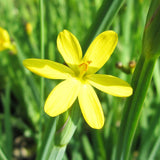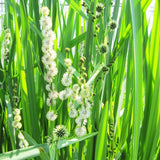Sisyrinchium Californicum Aquatic Pond Plant - Yellow Eyed Grass
Sisyrinchium californicum, commonly known as California Blue-eyed Grass, is a perennial flowering plant native to California and other western regions of North America. It belongs to the family Iridaceae. Here's a detailed description and care guide for Sisyrinchium californicum:
Description:
Sisyrinchium californicum forms clumps of grass-like foliage and produces delicate blue to violet flowers. The plant reaches a height of 12-18 inches (30-45 cm) with slender, erect stems. The leaves are narrow and linear, resembling grass blades, and grow in tufts from the base of the plant. The flowers are star-shaped and have six petals arranged in a radial pattern. Each flower lasts for one day but is often replaced by numerous others, creating a profusion of blooms.
Care Guide:
Lighting: Sisyrinchium californicum prefers full sun to partial shade. It thrives in bright, sunny locations, but it can tolerate some shade, particularly in hot summer climates. Aim to provide at least 4-6 hours of direct sunlight each day for optimal growth and flowering.
Water: This plant prefers moderately moist soil conditions. Water regularly, keeping the soil evenly moist but not waterlogged. Avoid allowing the soil to dry out completely between waterings, as it may cause stress to the plant. During hot and dry periods, increase watering frequency to prevent wilting.
Soil: Sisyrinchium californicum grows well in various soil types, including sandy, loamy, or clay soils. It prefers well-draining soil with good organic matter content. Amend heavy clay soils with organic matter, such as compost or well-rotted manure, to improve drainage and fertility.
Temperature: This plant is hardy in USDA hardiness zones 7-10. It is adapted to Mediterranean climates and can tolerate both cool and hot temperatures. Protect the plant from extreme temperature fluctuations and frost in colder zones.
Maintenance: Sisyrinchium californicum is a relatively low-maintenance plant. Remove spent flowers regularly to encourage continuous blooming. Deadhead the flowers by cutting the stem just above the base to promote new blooms. Divide the clumps every few years to prevent overcrowding and maintain plant vigor.
Propagation: This plant can be propagated through division or by sowing its seeds. Division is typically done in early spring or fall when the plant is not actively growing. Sow the seeds in well-prepared soil and lightly cover them with a thin layer of soil. Keep the soil moist until germination occurs.
Pests and Diseases: Sisyrinchium californicum is generally resistant to pests and diseases. However, it can occasionally be susceptible to slugs or snails. Monitor the plant for any signs of damage and take appropriate measures if necessary. Good air circulation and proper spacing between plants can help prevent diseases.
Sisyrinchium californicum adds beauty and color to garden beds, borders, or naturalized areas. It attracts butterflies and other pollinators, making it a valuable addition to wildlife gardens. By following these care guidelines, you can successfully grow Sisyrinchium californicum and enjoy its charming blue flowers throughout the blooming season.
Selection:
Research different species of marginal pond plants to find ones that suit your pond's conditions and your aesthetic preferences. Consider factors such as height, flower colour, foliage texture, and seasonal interest when selecting plants.
Placement:
Observe the natural conditions of your pond, such as sun exposure, soil type, and water movement, and choose plants that are adapted to those conditions. Create different planting zones around the pond, with plants that prefer wet soil closer to the water's edge and those that tolerate drier soil further away.
Sunlight:
Marginal plants typically thrive in full sun to partial shade. Some species can tolerate more shade, but for optimal growth and flowering, provide them with at least 6 hours of direct sunlight per day.
Water Depth:
Determine the water depth requirements of the marginal plants you choose. Some plants prefer water up to 6 inches deep, while others can tolerate water up to 12 inches or more. Ensure that the water level remains consistent within the preferred range for the chosen plants.
Soil:
Marginal plants prefer a rich, loamy soil that retains moisture but is not waterlogged. Amend the soil with organic matter, such as compost or well-rotted manure, to improve its fertility and drainage. Avoid using heavy clay soil, as it can become compacted and restrict root growth.
Planting:
Dig a hole slightly larger than the root ball of the plant and loosen the soil at the bottom. Place the plant in the hole, ensuring that the crown is level with or slightly above the soil surface. Backfill the hole with soil and gently firm it around the plant to eliminate air pockets. Water thoroughly after planting to settle the soil and provide initial hydration.
Mulching:
Apply a layer of organic mulch around the base of the plants to suppress weeds, conserve moisture, and regulate soil temperature.Use materials like straw, shredded bark, or compost, and maintain a depth of 2-3 inches.
Watering:
Marginal plants prefer consistently moist soil but should not be waterlogged. Monitor the moisture level regularly and water as needed to keep the soil evenly moist. During hot and dry periods, provide supplemental watering to prevent the soil from drying out.
Fertilization:
Marginal plants generally do not require heavy fertilization if the soil is nutrient-rich. However, if growth appears weak or leaves show signs of nutrient deficiencies, apply a balanced slow-release fertilizer according to the manufacturer's instructions.
Maintenance:
Remove any yellowing or dead leaves to maintain plant health and appearance. Divide overcrowded plants every few years to prevent competition for resources and promote vigorous growth. Prune back excessive growth to maintain a tidy appearance and to prevent plants from encroaching on other plants or the pond itself.
Winter Care:
Hardy marginal plants can withstand winter temperatures and require minimal care. Cut back dead foliage in late fall or early spring to tidy up the planting area. In colder regions, consider protecting tender plants with a layer of mulch or covering them with burlap during winter to prevent frost damage.
Monitoring and Troubleshooting:
Regularly inspect plants for signs of pests, diseases, or nutrient deficiencies. Address any issues promptly with appropriate treatments, such as organic insecticides, fungicides, or nutrient amendments. By following these detailed tips and providing proper care, you can create a beautiful and thriving planting zone around your pond, enhancing its visual appeal and supporting a diverse ecosystem.


































